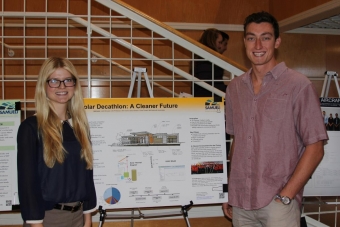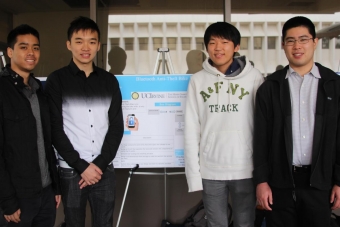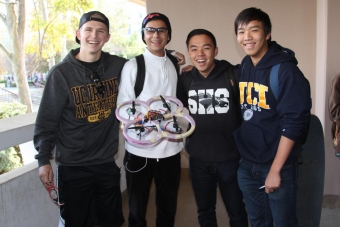Students Shine at Design Review Despite Rain

The biggest storm of the season did not deter the more than 400 senior engineering students from displaying their project goals at the Fall Design Review Friday, Dec. 12. However the rainy weather did cause the event to move indoors. Eighty teams of students set up poster displays in Engineering Gateway, Engineering Tower and the Calit2 atrium.
The student teams explained their projects to industry and faculty mentors as well as staff and other students. “The ambition from students this year is phenomenal,” said mechanical engineering Professor Mike McCarthy. “I’m looking forward to a year of challenging projects. It’s not going to be easy, but it will be exciting.” McCarthy noted that this was the first year in memory that it has rained on Fall Design Review.
The 80 projects ranged from a house designed to operate on renewable energy, to a low-cost microfluidic device that can detect HIV to an anti-theft bike lock operated through Bluetooth and a smartphone.
 Students in the freshman experiential learning program culminated their first quarter with a quadcopter flight contest. There were 223 students enrolled in the course this year, with 40 teams designing, building and testing radio-controlled (RC) quadcopters.
Students in the freshman experiential learning program culminated their first quarter with a quadcopter flight contest. There were 223 students enrolled in the course this year, with 40 teams designing, building and testing radio-controlled (RC) quadcopters.
“We changed from hovercrafts to quadcopters this year because drones are a very popular product in the technology field today,” says Lily Wu, director of academic innovation programs. “We wanted our students to apply the engineering design process to a prototype that has the potential to become a real product. Drones can be used in a variety of applications – package delivery, communications for military, or filming for movies are just a few examples.”
For the preliminary competition, the teams had to fly their quadcopters via remote control through a 15-by-30-feet course with two pylon obstacles. The copters needed to reach a height of 2 to 6 feet. Ten teams with the shortest flying times made it to the finals at Design Review where they were challenged to land the quadcopter in as many hoops placed on the floor as possible within 30 seconds.
The win ning team successfully landed in eight hoops to beat the second place team which landed in six hoops. Aidan Chin, Braeden Clewis, Gagik Hakobyan, Justin Ma and Prad Tantiwuttipong made up the winning team.
ning team successfully landed in eight hoops to beat the second place team which landed in six hoops. Aidan Chin, Braeden Clewis, Gagik Hakobyan, Justin Ma and Prad Tantiwuttipong made up the winning team.
“The students gained valuable design and fabrication experience whether they were able achieve a successful flight or not,” says Brandon Tsuge, a graduate student and co-instructor of the course. “They wouldn’t have been able to develop these hands-on skills in any other freshman engineering class. Hopefully they will build on these skills when they tackle an autonomous element of the project next quarter.”
